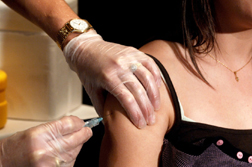Vaccinations for better or for worse?Adam Murdock, M.D.The Freeman Institute Nov. 02, 2009 |
Popular 
Claim Jewish Student Was 'Stabbed In The Eye' by Pro-Palestine Protester Draws Mockery After Video Released

Senate Passes $95B Giveaway to Israel, Ukraine, and Taiwan, Combined With TikTok Ban

'These Protesters Belong in Jail': Gov. Abbott Cheers Arrest of Pro-Palestine Protesters at UT Austin

Mike Johnson Pushes Debunked Lie That Israeli Babies Were 'Cooked in Ovens' On October 7

Biden Signs Bill to Give $95B to Israel, Ukraine and Taiwan, Ban TikTok
  There are some fundamental questions that should be asked of any proposed treatment including vaccines. Does it do what it claims it will do? What are the benefits? What are the risks? What are the alternatives? How has the proposed treatment been promoted to physicians and the public? Yet, as I have demonstrated in my last article entitled "Stop the Swine Whine," these questions have been largely ignored by H1N1 flu commentators, who have substituted propaganda, hysteria, and fear-mongering for legitimate information. There are some fundamental questions that should be asked of any proposed treatment including vaccines. Does it do what it claims it will do? What are the benefits? What are the risks? What are the alternatives? How has the proposed treatment been promoted to physicians and the public? Yet, as I have demonstrated in my last article entitled "Stop the Swine Whine," these questions have been largely ignored by H1N1 flu commentators, who have substituted propaganda, hysteria, and fear-mongering for legitimate information.It is under the backdrop of the H1N1 flu hysteria that the FDA has quietly approved another human papilloma virus (HPV) vaccine for girls and for the first time, an HPV vaccine for boys. These vaccinations, according to the vaccine makers, will dramatically lower cervical cancer rates in women and genital warts in men. Or will they? As usual, the truth is much more complicated. With the advent of regular Pap smear screening of women in the U.S., the mortality rate from cervical cancer has dramatically decreased. Now, compared to some other cancers like breast and lung cancer, cervical cancer kills a relatively small 4,000 women in the U.S. per year. As a result, the majority of cervical cancer victims come from the third world where regular screening is not the standard of care. While every death due to cervical cancer is regretful, will the vaccine really decrease these mortality numbers any further? The answer to this question is supremely important because if it is shown that the vaccine has no benefit or is only marginally effective, then the whole framework of HPV vaccination would be in doubt. In order to answer this question we must ask how 4,000 women could die from cervical cancer when they are receiving regular screening. Surely, a cancer that is known to take up to a decade or more to develop from initial pre-cancerous changes would be caught well in advance before it became problematic. So why are women still dying? The answer is intuitively obvious. The 4,000 are comprised of a subpopulation of women defined as underserved that don't go to the doctor to get screened in the first place, much less get vaccinated. It is frequently these women that show up in the emergency room with inoperable and incurable invasive cervical cancer. Therefore, it is also these women that contribute the vast majority of deaths related to cervical cancer. So why promote a vaccine to a population of women that are already getting regular screening and will not likely get any mortality benefit? Should not the vaccine makers be promoting their vaccine exclusively to the high-risk population that is not likely to obtain routine screening? Of course, this logical approach would not pay back any research and development investment or put money into the corporate offices of these companies. Withheld from the public by the mainstream media have been an increasing number of physicians and scientists coming out against the vaccine and its supposed benefits. Recently, for example, "Columbia University professors Sheila M. and David J. Rothman published an article in the Journal of the American Medical Assn." blasting Merck, which produces the Gardasil HPV vaccine "for paying grants to medical organizations that are strong advocates for vaccination. "˜Telling every mom she needs to get her daughters vaccinated to protect them from cancer is creating a market out of thin air,' David Rothman says. "˜They’re already protected' through regular Pap smears, he adds." (1) Another researcher, Dr. Diane Harper, who participated as the "lead researcher in the development of two human papilloma virus vaccines, Gardasil and Cervarix, said the controversial drugs will do little to reduce cervical cancer rates and, even though they're being recommended for girls as young as nine, there have been no efficacy trials in children under the age of 15." (2) She has also added that because the rates of cervical cancer are already so low that "even if we get the vaccine and continue Pap screening, we will not lower the rate of cervical cancer in the US." (2) The next logical question is that if all cervical cancer can be prevented by the HPV vaccine then why can't we just stop performing Pap smears in women and just give them the vaccine instead? When I have talked to patients and even some physicians about the HPV vaccine, I have consistently been presented with the misconception that the vaccine is 100 % protective against cervical cancer. The truth is that the vaccine protects against two strains of HPV "“ HPV 16 & 18, which are thought to be responsible for only 70% of cervical cancer cases. So despite the vaccine, women could be still infected with HPV strains that cause up to 30% of cancer cases. It is because of this that women need to continue regular screening just as they have already been doing. Therefore, the added layer of the vaccine adds nothing more than cost to the existing Pap smear screening regiment. In addition, there are no long term studies that demonstrate that the vaccine truly prevents cervical cancer itself and not just infection rates. There is also no data that shows that the protective effects of the vaccine will persist into a woman's 30s, 40s, and 50s when cervical cancer is most predominant. So far, the vaccine has been marketed, approved, and given to young women almost exclusively. What about the risks? The vaccine makers claim that the HPV vaccine carries no long-term side effects. However, the "Vaccine Adverse Event Reporting System (VAERS) has received more than 15,000 reports of reactions to the vaccine, including more than 3,000 injuries and 48 deaths" after patients received the Gardasil vaccine. (3) While these reactions may not be all attributable to the vaccine, it is clear that reactions, sometimes severe, have occurred after vaccination. Has this information caused the vaccine makers to withdraw their promotional material and cervical cancer reduction claims? Quite the contrary, their promotion efforts have continued. The Gardasil vaccine, with sales of $1.4 billion in 2008, has not only received generous advertisement promotion but has also been promoted through generous donations to physician organizations such as the American College of Obstetricians and Gynecologists (ACOG) and Society of Gynecologic Oncologists. It is these organizations that have further disseminated HPV vaccine hysteria to member OB/GYNs and primary care providers. In addition, "Merck has been lambasted for tactics such as lobbying lawmakers to make vaccination mandatory." (1) In a final straw, Merck has sought and been approved by the FDA to vaccinate boys with Gardasil. This vaccination, which as has been demonstrated can cause serious side effects, will now be given to boys in order to treat relatively innocuous genital warts and extremely rare penile cancer. I am sure that it is no coincidence that according to Bloomberg, "approval in boys could add as much as $200 million to $300 million in annual sales" to Merck. (4) What has been lost in all the disinformation has been the requirement of sexual intercourse for transmission of the Human papilloma virus. All it would take to put a stop to cervical cancer for good would be for providers to promote and patients to practice monogamy. As usual, this aspect has been downplayed by the vaccine makers. Adam Murdock, M.D. is founder of The Freemen Institute. References: 1. Weintraub, Arlene. Is Merck Overselling a Cancer Vaccine? BusinessWeek. August 27, 2009. 2. Brinkmann, Susan. Gardasil Researcher Drops a Bombshell. The Bulletin. October 25, 2009. 3. Brinkmann, Susan. New HPV Vaccine Making Girls In UK Sick. The Bulletin. September 20, 2009. 4. Pettypiece, Shannon. Merck Wins U.S. Approval for Gardasil Vaccine in Boys. Bloomberg. October 16, 2009. |



